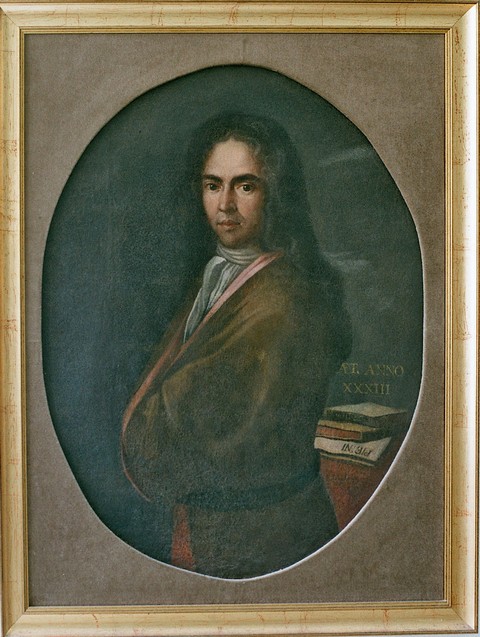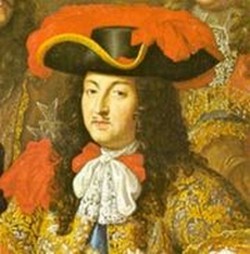
Sponsored Ads
|
| The CRAVAT instead of a TIE and NECKTIE |
| By Linda Prosenjak |
Published
10/16/2008
|
Croatian Language , History , Events
|
Unrated
|
|
|
|
Ivan Gundulić wore a cravat before Louis XIV
 Ivan Gundulić (1589-1638), a famous Croatian poet, with his cravat in 1622. It is the first cravat known in history.
THE CRAVAT UMJESTO TIE ILI NECKTIE
Iz fraze To tie the cravat nastala je riječ tie!
Povodom Međunarodnog dana kravate 18. listopada pozivamo sve korisnike i govornike engleskog jezika da čvorovani rubac oko vrata nazovu prvotnim imenom the cravat umjesto tie ili necktie.
Modu nošenja čvorovanog rupca - kravate, kao i riječ "cravate" - u obliku "the cravat", u Englesku je prenio Charles II, po povratku iz egzila, 1660. godine. Kasnije, iz fraze "to tie the cravat" razvili su se u engleskom jeziku novi nazivi za kravatu - "tie" i "necktie".
Prvotni naziv "the cravat" danas u engleskom jeziku ima reducirano značenje i označava šal koji je opušteno vezan oko vrata, najčešće stavljen unutar košulje.
S obzirom da je riječ "kravata" izvorni naziv za čvorovani rubac te prihvaćen u većini svjetskih jezika, Academia Cravatica predlaže da se i u engleskom jeziku za kravatu, umjesto riječi "tie" i "necktie" reafirmira prvotni naziv "the cravat"...
Etimologija riječi cravat ima hrvatske korijene. Pojam cravate, kao oznaka za rubac, kravatu koji su vrijeme Tridesetogodišnjeg rata hrvatski vojnici nosili čvorovanu oko vrata, ulazi u francuski leksik sredinom XVII. stoljeća, u vrijeme kralja Luja XIV. Naime, u to su vrijeme Francuzi Hrvate nazivali les cravates, dok je njemački termin glasio Krawaten. (iz knjige "Kravata - hrvatski ures na vratu svijeta", Danijel Načinović, Academia Cravatica, 2007.)
|
THE CRAVAT INSTEAD OF A TIE AND NECKTIE
The word tie has developed from the phrase To tie the cravat!
On the occasion of the International Day of The Cravat on the 18th of October we invite all the English speaking individuals to call the knotted scarf around their neck by it's
original name the cravat instead of tie and necktie.
The fashion of wearing knotted scarves in England as well as the word "cravate" in the form of "the cravat" introduced King Charles II in 1660, upon his return from exile. Later on from the expression „to tie the cravat“ a new name developed for the cravat in English - the "tie" and "necktie".
Today, the original word cravat in modern English signifies a wide straight piece of fabric worn loosely tied round the neck, most often tucked inside an open-necked shirt.
Considering that the word "cravat" originally meant a tied scarf, and has been accepted by the majority of languages in the world to denote the modern tie, the proposal of Academia Cravatica is to re-establish, also in English, the original word "cravat" instead of the words "tie" and "necktie".
The etymology of the word "cravat" has Croatian roots. The expression "cravate" symbolizing the scarf - cravat worn by Croatian soldiers in The Thirty Years war entered the French lexic in the middle of the XVII century, during the reign of the King Louis XIV. In those days the Croats were called "les cravats" in France, and the corresponding term in German was "Krawaten" ( from the book "The Cravat - Croatian adornment on the world's shirt", Danijel Načinović, Academia Cravatica, 2007.)
|  Louis XIV (1638-1715), a famous French emperor, with his cravat. Note that he was born precisely in the year when Ivan Gundulić died.
IVAN GUNDULIĆ NOSIO JE KRAVATU PRIJE LUJA XIV.
Iako se do sada vjerovalo kako je francuski kralj Luj XIV. na jednom portretu nastalom krajem 16. stoljeća prvi koji na nekoj slici nosi kravatu, odnosno rubac kao njezinu preteču, sada je očito da je najstariji portret sa nositeljem kravate ipak nastao u jednom hrvatskom gradu. Riječ je dakako o Dubrovniku.
Naime, nedavno je otkriveno da slavni dubrovački pjesnik Ivan Dživo Gundulić na portretu iz 1622. godine koji se čuva u Kneževu dvoru, oko vrata nosi rubac koji se vezivao poput kravate. Ta spoznaja daje nove naglaske o liku dubrovačkog velikana Gundulića, ali nove činjenice ujedno rasvjetljuju još jednom i podrijetlo kravate.
Sve to zapravo znači da se u Dubrovniku kravata počela nositi čak 55 godina prije nego u Francuskoj, a sada za to postoji i konkretan dokaz. Iako je spomenuti Gundulićev portret godinama izložen u Kneževu dvoru, zanimljivo je kako se sve do sada nije uočilo da veliki pjesnik ne nosi obični rubac već upravo kravatu.
"Dubrovnik je jedan od najvećih hrvatskih brandova, jednako kao i kravata, a ovim otkrićem ta se dva branda još više nadopunjuju", istaknula je među ostalim na konferenciji za novinare priređenoj u atriju dubrovačke palače Sponza povodom tog otkrića, Mirta Hansal iz Odnosa s javnošću ustanove "Academia Cravatica". Osim toga, Dubrovnik i kravata su ujedno svaki za sebe i višestoljetna priča o slobodi.
Uz taj ekskluzivitet, u Dubrovniku je spomenuto kako je nedavno također otkriven i zemljovid iz 17. stoljeća koji se odnosi na područje Slavonskog Broda, a na kojemu je vidljivo da je jedna utvrda nazvana Cravatten Statt.
"Zemljovid je izradio Nizozemski kartograf Nikola Sparr de Bensdorf, a u nastojanju da zabilježi što precizniji raspored vojnih snaga Habsburške monarhije prema Osmanskom carstvu, kako konjice i pješaštva tako i zapovjednog mjesta u sklopu utvrde za razdoblje od 10. do 12. listopada 1697. godine, unio je i brojne toponime. Upisao je među ostalim i naziv utvrde 'Cravatten Statt'. Taj je oblik u arhaičnom njemačkom jeziku označavao hrvatski grad dok ga danas nalazimo u više jezičnih varijanti kao naziv za kravatu. Iz svega je neosporno da kravata potječe od Hrvata", naglasio je u palači Sponza povjesničar umjetnosti i kustos Muzeja kravate u osnivanju, Nikola Albaneže.
No, tu svakako nije kraj novim povijesnim i drugim otkrićima i zanimljivostima vezanima uz podrijetlo kravate kao ni uvijek jedinstvenim projektima "Academie Cravatice" kao istinskog
promicatelja branda 'Croata', zahvaljujući kojima kravata diljem svijeta postaje sve više prepoznatljiva kao jedan od najizvornijih hrvatskih brandova.
Renata Debeljak
Izvor: Academia Cravatica
|
IVAN GUNDULIĆ WORE A CRAVAT BEFORE LOUIS XIV
Although it has always been thought that the French King Louis XIV was the first to wear
something resembling a cravat, or a scarf as its predecessor, on a portrait dating from the end of the 16th century, it is now clear that the oldest portrait of someone wearing a cravat was painted in a Croatian city. This was of course Dubrovnik.
That is to say, it was recently discovered that the famous Dubrovnik poet, Ivan Dživo Gundulić, on a portrait dating from 1622 and kept in the Rector’s Palace, is wearing a scarf around his neck, tied like a
cravat. This insight gives a new emphasis to the character of the great man of Dubrovnik, Gundulić, but the new facts also shed light once more on the origins of the cravat.
This all means in fact that the cravat was worn in Dubrovnik as long as 55 years before it was worn in France, and there is real evidence to support this fact. Although this portrait of Gundulić has been on show in the Rector's
Palace for many years, it is interesting that it has never been noticed before now that the poet is not wearing a normal scarf, but
precisely a cravat.
"Dubrovnik is one of the greatest Croatian brands, just like the cravat, and with this discovery these two brands now complement one another even more" it was pointed out, amongst other things, at the press
conference in the atrium of the Dubrovnik Sponza Palace, on the occasion of this discovery, by Mirta Hansal, a public relations
officer from "Academia Cravatica". Moreover, Dubrovnik and the cravat are each in their own way a symbol of the centuries long story of freedom.
As well as this exclusive, it was mentioned in Dubrovnik that a 17th century map was recently discovered in the area of Slavonski Brod, on which it is visible that a fortress there is called Cravatten Statt.
"The map was drawn by the Dutch cartographer Nikola Sparr de Bensdorf, and in an attempt to record as precisely as possible the layout of military forces in the Habsburg Monarchy, facing the Ottoman Empire, both cavalry and infantry, as well as command posts, as part of the fortifications for the period from 10th to 12th October 1697, he added a number of toponyms. He wrote amongst other things the name of the fortress as Cravatten Statt. This form of archaic German language indicated a Croatian castle, whilst today we find it in various linguistic forms as the word for a cravat. From all this it is indisputable that the cravat originates from the Croats", it was pointed out in the Sponza Palace by the art historian and curator of the Museum of the Cravat, which is in the process of being established, Nikola Albaneže.
However, this certainly is not the end of the new historical and other discoveries and interesting facts related to the origins of the cravat, nor the always unique projects run by Academia Cravatica, as the true promoter of the Croata brand, thanks to which the cravat is becoming increasingly recognized throughout the world as one of the most original Croatian brands.
Renata Debeljak
Source: Academia Cravatica
| Contact: Linda Prosenjak, Academia Cravatica, Zagreb, e-mailFormated for CROWN by prof.dr. Darko Žubrinić
Distributed by www.Croatia.org . This message is intended for Croatian Associations/Institutions and their Friends in Croatia and in the World. The opinions/articles expressed on this list do not reflect personal opinions of the moderator. If the reader of this message is not the intended recipient, please delete or destroy all copies of this communication and please, let us know!
|
Related Articles
Related Links
Comments
-
Comment #1
(Posted by Megan)
Hey. It is hard to fight an enemy who has outposts in your head.
I am from Bangladesh and now study English, please tell me right I wrote the following sentence: "American express card promotions - free points, airline tickets, more."
With love :o, Megan.
Submit Comment
|
|